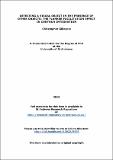Files in this item
Detecting a visual object in the presence of other objects : the flanker facilitation effect in contour integration
Item metadata
| dc.contributor.advisor | Vishwanath, Dhanraj | |
| dc.contributor.advisor | Harris, Julie | |
| dc.contributor.author | Gillespie, Christopher | |
| dc.coverage.spatial | xii, 230 p. | en_US |
| dc.date.accessioned | 2016-09-12T11:56:54Z | |
| dc.date.available | 2016-09-12T11:56:54Z | |
| dc.date.issued | 2015 | |
| dc.identifier.uri | https://hdl.handle.net/10023/9479 | |
| dc.description.abstract | When an observer views a complex visual scene and tries to identify an object, his or her visual system must decide what regions of the visual field correspond to the object of interest and which do not. One aspect of this process involves the grouping of the local contrast information (e.g., orientation, position and frequency) into a smooth contour object. This thesis investigated whether the presence of other flanking objects affected this contour integration of a central target contour. To test this, a set of Gaborized contour shapes were embedded in a randomised Gabor noise field. The detectability of the contours was altered by adjusting the alignment of the Gabor patches in the contour (orientation jitter) until a participant was unable to distinguish between a field with and without a target shape (2-AFC procedure). By varying the magnitude of this jitter, detection thresholds were determined for target contours under various experimental conditions. These thresholds were used to investigate whether contour integration was sensitive to shared shape information between objects across the visual field. This thesis determined that the presence of flanking contours of a similar shape (as the target) facilitated the detection of a noisy target contour. The specific results suggest that this facilitation does not involve a simple template matching or shape priming but is associated with integration of shape level information in the detection of the most likely smooth closed contour. The magnitude of this flanker facilitation effect was sensitive to a number of factors (e.g., numerosity, relative position of the flankers, and perimeter complexity/compactness). The implication of these findings is that the processing of highly localised contrast and orientation information originating from a single object is subject to modulation from other sources of shape information across the whole of the visual field. | en_US |
| dc.language.iso | en | en_US |
| dc.publisher | University of St Andrews | |
| dc.subject.lcc | BF293.G5 | |
| dc.subject.lcsh | Form perception | en_US |
| dc.title | Detecting a visual object in the presence of other objects : the flanker facilitation effect in contour integration | en_US |
| dc.type | Thesis | en_US |
| dc.contributor.sponsor | Engineering and Physical Sciences Research Council (EPSRC) | en_US |
| dc.type.qualificationlevel | Doctoral | en_US |
| dc.type.qualificationname | PhD Doctor of Philosophy | en_US |
| dc.publisher.institution | The University of St Andrews | en_US |
This item appears in the following Collection(s)
Items in the St Andrews Research Repository are protected by copyright, with all rights reserved, unless otherwise indicated.

